Sustainability Treehouse
Project Overview
The Sustainability Treehouse, an interactive interpretive and gathering facility in the forest, was conceived and created as a unique icon of outdoor adventure, environmental stewardship and high performance building design. It provides dynamic educational and gathering spaces for exploring and understanding the site and ecosystem at the levels of ground, tree canopy, and sky. It captures the wonder of childhood adventure and places environmental education at the forefront of meaningful and immersive outdoor experiences for thousands of annual visitors.
Design & Innovation
Collaborating closely with multiple stakeholders, the designers led a multidisciplinary team to achieve a high-performance building that is on target for Living Building certification. The Living Building Challenge requires the building to produce and manage all of its own energy, water and waste on site. This project uses innovative mechanical, electrical, and plumbing systems such as a 6,450-watt photovoltaic array, two 4,000-watt wind turbines, and a 1,000-gallon cistern and water cleansing system.
Towering 125 feet above grade, the Treehouse is supported by a Corten steel frame engineered to create a seamless fusion of architecture and structure. Visitors ascend to multiple indoor and outdoor platforms, experiencing the forest from many vantages. Interactive exhibits showcase and celebrate sustainable technologies, revealing how systems work and highlighting performance.
One of the most aggressive energy and carbon reduction strategies was to reduce the initial building program from 20,000 square feet of interior space to 3,360 square feet, taking advantage of outdoor terraces, exterior stairs and landings, and the site to accommodate the desired activities and experiences. Overall, the Treehouse serves as a living classroom to educate visitors about sustainable design strategies, as well as the important balance of stewardship and resources in the region and beyond.
Regional/Community Design
The design of the Treehouse is fundamentally rooted in place, emerging from site and regional factors and influences. The primary outward expression is imparted by a recycled-content weathering steel structure, locally-harvested wood, and an aesthetic inspired by historic industrial structures that required both innovation and adaptation to the challenging landscape.
The design also reflects the ingenuity of “pioneering engineering,” a childhood educational tradition based on team development of towers and structures from elemental materials and methods. The layering of the Treehouse parallels the layering of its setting – from the forest floor to the canopy and the sky. Promoting the virtues of environmental stewardship, building systems have been made visible, becoming overt expressions of site-responsive, sustainable design.
The Treehouse is located within a larger conservation and recreational area served by organized transportation logistics. Visitors travel in groups to the site; park in designated lots near the outskirts; and are transported via shuttle to centralized points within the recreational area. The majority of visitors who explore the Treehouse arrive on foot from other locations throughout the larger area. A multitude of activities and adventures are all within walking distance, and an accessible trail unites all areas within the central core.
Metrics
Land Use & Site Ecology
Located within a 10,600-acre post-industrial tract of land in rural West Virginia, the site is undergoing a transformation from a place of former resource extraction--contour mining and logging--to a restored landscape that teaches conservation and environmental stewardship. The weathered steel structure of the Treehouse recalls the cultural industrial heritage of the site, such as the ingenious vertical conveyance relicts of the mining industry, but enlists this aesthetic toward environmental education and resource conservation, rather than resource extraction.
The tapered design of the structure defers to foliage and helps minimize the structure’s impact to the site and natural environment, while visually integrating with the vertical forest elements that currently exist on site. Aggressive tree protection measures of the second-growth mixed deciduous forest during construction, coupled with additional enhancement of native vegetation - much of it edible - enable the site to grow and illustrate forest stewardship. Native edible plants increase opportunities for forest foraging by visitors, as well as browsing by wildlife.
Bioclimatic Design
The Treehouse connects visitors with the site and teaches about sustainable design and environmental stewardship through immersive experiences such as climbing, exploration, contemplation, and observation of nature from new vantage points. Indoor and outdoor spaces celebrate the earth, the trees, water, and the sky.
The indoor programmatic elements are designed as two well insulated “galleries” with minimal air leakage, elevated off the ground within the 125-foot structure. Immersed within the deciduous forest canopy, the galleries rely on natural cooling and foliage for shading. The surrounding forest canopy imparts a soft dappled daylight to interior spaces and exterior platforms, while the structure itself phototropically reaches above the canopy to harvest solar energy during fair weather and wind energy during passing storms. Establishment of a water budget and analysis of annual rainfall, including frequent rain events throughout the intensive summer months, helped size the cistern for projected use. Engaging and interactive exhibits within both the indoor and outdoor spaces reveal and make tangible aspects of water and energy conservation, habitat, and bioclimatic design.
Light & Air
The Sustainability Treehouse consists of indoor and outdoor galleries that are designed to teach visitors about elements of sustainability through immersive experiences and dynamic circulation throughout the structure. All indoor and outdoor spaces are designed to connect users to views, daylight, and natural cooling, either through large, operable vertical east- and west-facing glazing planes (shaded by the tree canopy throughout the summer), north- and south-facing openings, or diffuse skylights. The Treehouse is designed to optimize natural light and only rely on electric lighting for exhibit foci or during very low light conditions. One hundred percent of the spaces are served by natural cooling and all take advantage of the deciduous forest canopy. These strategies of transparency and natural ventilation, combined with a rhythm of indoor and outdoor experiences, serve to connect users to the site and regional context.
Metrics
Water Cycle
The Treehouse brings people together to learn about water and strategies to reuse and conserve the resource. A kinetic rain chain celebrates the capture of rainwater and introduces the story of the water cycle on-site. A composting toilet system has been used to reduce the domestic cold water required by the building. No water is required for toilet flushing and no water is added to the sanitary system from toilet usage. To further reduce regulated potable water use, rainwater is collected, filtered, treated, and distributed to the lavatories, water fountains, and the mop sink. The small amount of grey water created is being collected in a lift station and pumped to the black water tank in a nearby location. In addition:
• One-hundred percent of precipitation is managed on site at the comfort station.
• The small amount of wastewater generated on site is pumped to a centralized blackwater system. However, the amount of waste water created has been significantly reduced by the use of composting toilets.
• The predicted annual regulated potable water use is zero; only rainwater is used.
Metrics
Energy Flows & Energy Future
The Sustainability Treehouse demonstrates unique innovation in energy flow through a design that reduces demand and utilizes renewable and on-site energy sources to result in a building that produces more energy than it consumes on site. Conservation strategies to reach this goal include a high performance building envelope, optimal site orientation, daylighting, naturally weathering materials (minimal finishes), and expansion of the interior comfort range to suit the recreational site. Renewable energy sources include photovoltaic panels, wind turbines, and a future central plant geothermal collector. These renewable features provide a visible demonstration of the alternative energy sources used and provide an additional layer of education to the visitor. The predicted EUI excluding on-site renewable energy contribution is 14.9 kBtu/sf/yr; the predicted EUI, including on-site renewable energy contribution is (-0. kBtu/sf/yr ), a net-positive energy production relative to demand. The results represent a 69% reduction in building energy below an ASHRAE 90.1 code baseline, prior to accounting for renewable energy sources associated with the structure. A 6,450-watt photovoltaic array mounted on top of the structure and wind energy produced by two 4,000-watt vertical axis wind turbines turbines mounted within the top of the structure amount to a net positive building.
Metrics
Materials & Construction
The Sustainability Treehouse utilized a range of regionally produced or site-salvaged materials that emphasized simplicity, durability, and contextual appropriateness. Following the Living Building Challenge (LBC), all materials used on the project complied with the LBC red list criteria, were locally sourced per LBC procurement limits, followed a Material Conservation Management Plan, and met the LBC criteria of waste-stream diversion during construction. The Treehouse took advantage of naturally weathering materials to significantly reduce the need for finishes, protect environmental quality, and minimize ongoing maintenance. Site-salvaged oak and locally-harvested FSC-certified black locust siding and decking were used to blend closely with the natural environment. This simple palette of materials provides a neutral backdrop to the featured exhibits and renewable features which rise to attract the attention of visitors and help further demonstrate sustainable practices.
One of the most aggressive strategies to reduce materials, overall, was the drastic reduction of the interior building program from an initial 20,000 square feet to approximately 3,360 square feet. This reduction was accomplished, in large part, through the recognition that exterior spaces could fulfill programmatic goals, and through the understanding that the building itself would provide learning opportunities that didn't need to be duplicated with discrete exhibits.
Long Life, Loose Fit
Located within the heart of the Summit Bechtel Reserve, the Treehouse is designed as a long-term, permanent facility that sets the standard for sustainable design and stewardship for the site. The Summit serves as the new permanent home for the Jamboree, which is held during an intensive two-week period every four years and attended by up to 50,000 scouts and volunteers. In addition, the site also hosts annual events and local school and educational/recreational programs throughout the year. This pattern of concentrated, intensive summer use, intermittent swing-season use, and winterization provided an unusual design challenge for the project. In response, the Treehouse accommodates summer crowding, small group use during the spring/fall, and 'hibernation' during the winter. During the summer, the Treehouse is opened to capture natural breezes and shaded by the surrounding tree canopy. During spring and fall, windows and vents are calibrated to achieve interior comfort. Solar and wind power provide minimal heating when needed during the swing seasons and winter hibernation.
Simple, open floor plans, coupled with a hidden grid of potential attachment points for exhibits, allow for adaptability of exhibits, education, and programs over time. The minimal palette of naturally weathering materials minimize maintenance.
Collective Wisdom & Feedback Loops
From the earliest stages of design, and through a series of on-site charrettes, the integrated design team enlisted both physical models and BIM as collaboration and live feedback tools. Energy goals were established during programming and schematic design, and the goals were initially vetted based on comparable building type, climate data, and square footage. During design development, more detailed energy modeling using DesignBuilder established the design energy use intensity (EUI).
Testing using large-scale physical models under a heliodon and a simulated overcast sky helped the team and client to quantitatively and qualitatively evaluate the effectiveness of daylighting. Results optimized the glazing frit pattern (for daylight and bird protection), and revealed the need for skylights to balance daylight throughout the middle of each of the exhibit "boxes".
A post-occupancy evaluation/survey was conducted during July 2013 (2,000 responses from amongst 23,600 visitors), and beyond comments such as "smashing hit" and "magical", results revealed opportunities for more effective staffing and management patterns, additional exhibit ideas and/or modifications, and opportunities to more overtly integrate the Treehouse experience with the new Sustainability Merit Badge.
In support of LBC certification, the client is in the process of monitoring and calibrating building systems to optimize performance.
Other Information
The larger site for the Treehouse, the Summmit Bechtel Reserve, is anticipated to provide increasing support over time for a burgeoning new market sector for the region, a shift from resource extraction to outdoor recreation, environmental education, and hospitality. As successive future phases of development within the Summit Core are developed, and as use of the site increases, significant local job growth is expected.
Every scout attending the Jamboree is required to donate one full day of service to the community. The economic contribution of an estimated 25,000-50,000 days of service every four years on a range of project types is important for the region, but the lessons the scouts take home with them throughout the nation, though incalculable, are perhaps even more significant.
The cost of the Treehouse was 7.7 million. The client recognized the importance of investing in a variety of renewable technologies and visible building systems as teaching tools for sustainable design. In this sense, the building itself serves as a teacher and critically supports educational programming, minimizing the need for additional supplemental materials and displays.
PreDesign:
The design process was conducted through a series of intensive, on-site, interdisciplinary charrettes, followed by focused periods of coalescing and refinement. For instance, the kickoff design charrette took place over the course of a ten day period, during which the design of the Treehouse underwent major square-footage reductions for interior space, initial energy analysis, massing, and early schematic design. By the end of this first charrette, the team had developed working BIM files, simple physical models, and schematic design documents and renderings for fundraising. This condensed, accelerated design process enabled streamlined and informed decision making, as well as full team buy-in on design direction.
Design:
Throughout Design Development and Construction Documentation, additional interdisciplinary collaboration and testing guided design refinements. Energy modeling, water budgeting, and daylight testing optimized building/site systems and glazing. Modeling revealed that the evacuated-tube solar collectors initially planned for the Treehouse would not provide a significant enough contribution to justify their ultimate inclusion. Likewise, aggressive stack ventilation equipment that was initially specified was also determined not necessary; the elimination of this equipment during the design phases helped lower the project cost.
Construction process:
Aggressive tree protection measures and monitoring by the client, the construction administration team, and the general contractor preserved the surrounding forest. The maturing trees that surround the Treehouse are critical not only for visitor experience, but also for building performance, providing much needed shade throughout the hot summer months.
Operations/maintenance:
• Commissioning: In support of LBC certification, the client is in the process of monitoring and calibrating building systems to optimize performance.
• Measurement & verification/post-occupancy evaluation: A July 2013 post-occupancy evaluation/survey revealed opportunities for more effective staffing and management patterns, additional exhibit ideas and/or modifications, and opportunities to more overtly integrate the Treehouse experience with the new Sustainability Merit Badge.
Additional Images
Project Team and Contact Information
| Role on Team | First Name | Last Name | Company | Location |
|---|---|---|---|---|
| Landscape Architect | Nelson Byrd Woltz | |||
| Structural Engineer | Tipping Mar | |||
| MEP Engineer | Integral Group | |||
| Exhibit Design | Volume, Inc./ Studio Terpeluk | |||
| Geotechnical | S&ME | |||
| Code Consultant | FP&C Consultants | |||
| Contractor | Swope Construction |


















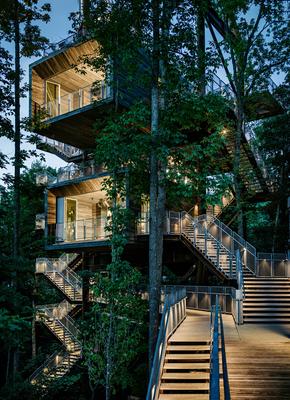
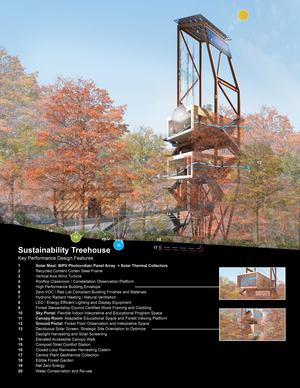
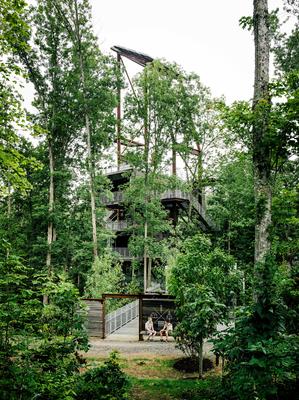
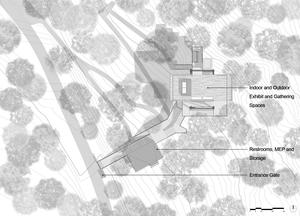
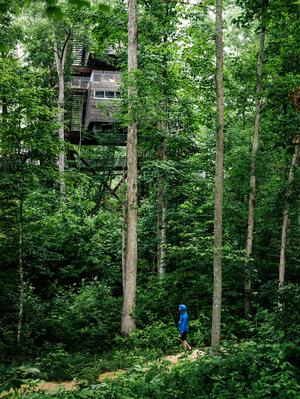
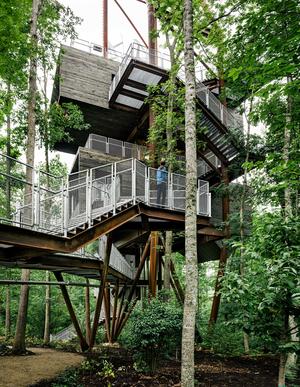
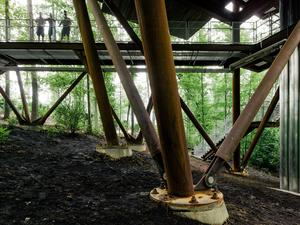
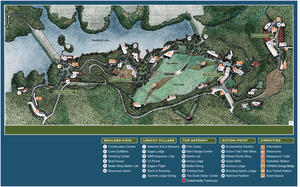
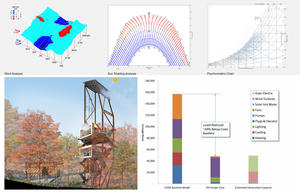
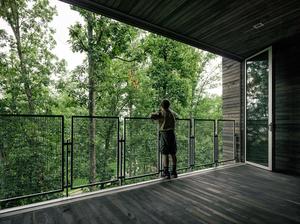
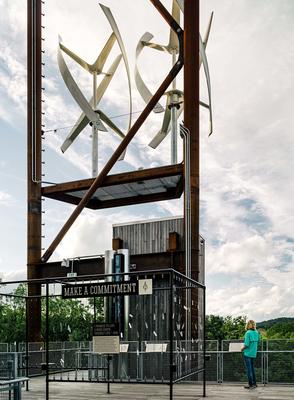
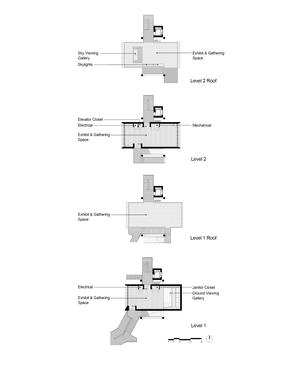
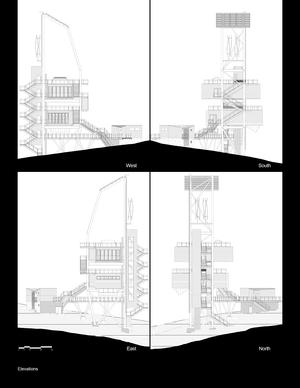
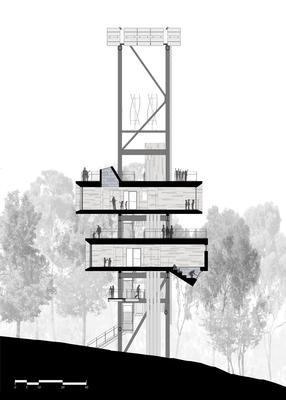
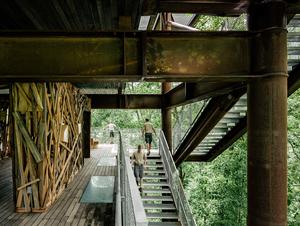
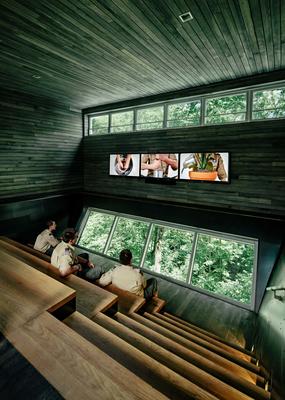
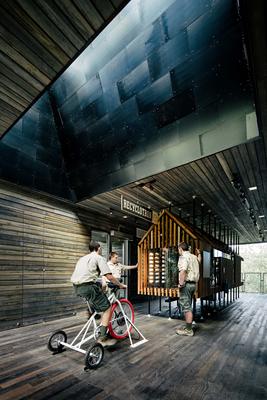
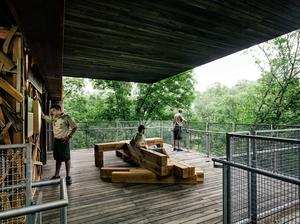


The project introduces sustainability in a playful manner by getting Boy Scout campers up into the trees in order to explore the forest canopy and to learn in the "living classrooms". The former strip mine site has been transformed to better fit it's natural landscape. The structure exhibits a very exuberant and expressive design while being contextual and respectful of the site. It speaks to all seven principals of the Living Building Challenge including net zero energy and water. The project makes sustainable building techniques easily accessible and understandable.